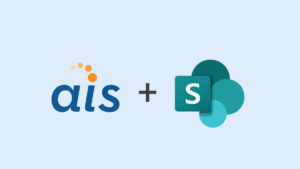 My decision to join AIS six years ago was a revelation. After almost seven years spent working as an embedded IT analyst for various government customers, I joined AIS to support a customer who was implementing SharePoint. I soaked up everything I could about this (at the time) brave new world of SharePoint. I loved it.
My decision to join AIS six years ago was a revelation. After almost seven years spent working as an embedded IT analyst for various government customers, I joined AIS to support a customer who was implementing SharePoint. I soaked up everything I could about this (at the time) brave new world of SharePoint. I loved it.
SharePoint 2003 had been available for use in my previous office where I had initially set up out-of-the-box team sites for working groups to support a large department-wide initiative. I found it empowering to quickly set up sites, lists and libraries without any fuss (or custom coding) to get people working together. Working with my new team, I gained insight into what we could do with this tool in terms of workflow, integration and branding. It got even better when we migrated to SharePoint 2007. We made great strides in consolidating our websites and communicating to those who were interested exactly what the tools could do in terms of collaboration and knowledge management.
This ability for a power user to quickly create a variety of new capabilities exposed a deeper customer need – easier communications with IT. While we had all this great expertise and firepower to create and maintain IT tools and services, our core customer base did not have an easy way to quickly and reliably communicate their needs in a manner that matched their high operational tempo. It was a problem. We needed a way for our customers to quickly and easily communicate with us in order to really hear what they needed to meet their mission goals and work more effectively.
We created the Customer Engagement Managers (CEM) Program to help ease communication hurdles, thereby helping IT to be more responsive to the mission. The CEM concept focuses on embedding IT power users from the CIO directly throughout customer offices to help the organization understand their current IT tools, articulate needed business process improvements and streamline how we develop and integrate these new tools.
I was lucky enough to be asked to join this team of “CEMs” at the ground level. Each of us came to the team with a unique set of specialized IT skills, including SharePoint and custom applications knowledge, mobile and video communication expertise, and training and overall project management experience. Together, our team has combined our talents into a cohesive unit with the capacity to identify these gaps, communicate with our customers in plain language and liaise with our business analysts and developers to collect requirements and lay the foundation for useful solutions that fit the needs quickly and effectively.
By taking responsibility for specific offices within the organization, we are each able to understand the unique personalities and quirks of each grouping of offices. Embedding ourselves further integrates us with our customers. We are “one of them” and as such, have a rare perspective into how these individuals and teams work.
CEMs have been in place in for several years and in this time, we have been able to accomplish some pretty big goals for our customers. We have:
- Helped our customer, the IT provider, establish solid relationships with their customer’s leadership, action officers and administrative staff.
- Confirmed our customer’s IT provider is service-oriented positions as “go-to” people for anything IT-related.
- Enabled rapid business process improvement through the use of business intelligence tools such as SharePoint, CRM and a host of both out-of-the-box and custom solutions.
- Eliminated legacy capabilities that were unused and provided limited value to the customer, and redirected those resources to highly desired capabilities that have a huge and positive impact on our customer’s mission.
- Developed numerous solutions, many in less than a day, in response to immediate needs of the core customers, without subjecting these requirements and customers to an arduous review and approval process that characterizes ‘disconnected’ IT shops.
The CEM program continues to grow and thrive in an environment fraught with uncertainty and economic change. We are successfully bridging the gap between capabilities the customers need and what the organization can provide them. We serve them by having a solid understanding of their unique missions and priorities, communicating with them clearly and proving our value through repeated successes incorporating SharePoint tools and capabilities into their daily lives. As the face of AIS at the most fundamental level — among our customers — we embody a most important value: true customer-focused service.






